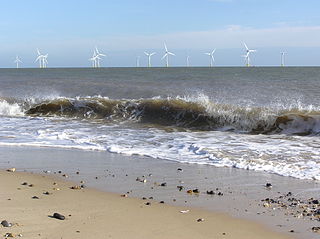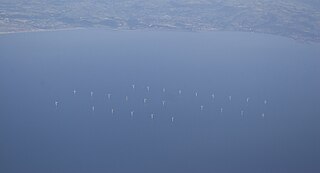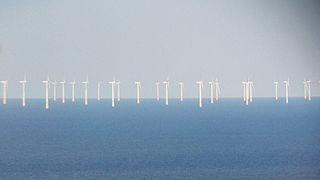
The Scroby Sands Wind Farm is a wind farm located on the Scroby Sands sandbank in the North Sea, 2.5 kilometres (1.6 mi) off the coast of Great Yarmouth in eastern England, United Kingdom. It was commissioned in March 2004 by Powergen Renewables Offshore, a division of E.ON UK. It has a nameplate capacity of 60 megawatts and is able to produce power to supply 41,000 households. Between 2005 and 2010, its capacity factor was between 26 and 32%. Its levelised cost has been estimated at £105/MWh.

The Kish Bank is a shallow sand bank approximately 11 kilometres (7 mi) off the coast of Dublin, in Ireland. It is marked by the Kish Lighthouse, a landmark visible to sailors and ferry passengers passing through Dublin Bay and Dún Laoghaire harbour.

The London Array is a 175-turbine 630 MW Round 2 offshore wind farm located 20 kilometres (12 mi) off the Kent coast in the outer Thames Estuary in the United Kingdom. It was the largest offshore wind farm in the world until Walney Extension reached full production in September 2018.

Greater Gabbard is a 504 MW wind farm, built on sandbanks 23 kilometres (14 mi) off the coast of Suffolk in England at a cost of £1.5 billion. It was completed on 7 September 2012 with all of the Siemens SWT3.6–107 turbines connected. Developed as a joint venture between Airtricity and Fluor, it is now jointly owned by SSE Renewables and RWE.

Wind power is the fastest-growing renewable energy technology in Scotland, with 16,648 megawatts (MW) of installed wind power capacity by Q2 2024. This included 9,756 MW from onshore wind in Scotland and 2,971 MW of offshore wind generators. The largest onshore wind farm in the UK is Whitelee, just south of Glasgow, with 215 turbines and a total capacity of 539 MW.
Atlantic Array was a proposed offshore wind farm in the Bristol Channel, off the coast of North Devon and South Wales, United Kingdom. It was a development by RWE Npower Renewables. With a planned 1.2 gigawatt capacity, it would have been one of the world's largest offshore wind farms. The project was cancelled in November 2013.

North Hoyle Offshore Wind Farm is Wales' first offshore wind farm, and the UK's first major offshore renewable power project. Situated in Liverpool Bay, it commenced operation in 2003.

Rhyl Flats Offshore Wind Farm is a 25 turbine wind farm approximately 8 km north east of Llandudno in North Wales. It is Wales' second offshore wind farm and the third offshore wind farm to be built within Liverpool Bay. It has a maximum rated output of 90 MW.

Gwynt y Môr is a 576-megawatt (MW) offshore wind farm located off the coast of north Wales and is the fifth largest operating offshore windfarm in the world. The farm has 160 wind turbines of 150 metres (490 ft) tip height above mean sea level.

Offshore wind power or offshore wind energy is the generation of electricity through wind farms in bodies of water, usually at sea. There are higher wind speeds offshore than on land, so offshore farms generate more electricity per amount of capacity installed. Offshore wind farms are also less controversial than those on land, as they have less impact on people and the landscape.

As of May 2024, wind power in the Netherlands has an installed capacity of 11,611 MW, 40.9% of which is based offshore. In 2022, the wind turbines provided the country with 18.37% of its electricity demand during the year. Windmills have historically played a major part in the Netherlands by providing an alternative to water driven mills.

Nordsee-Ost offshore wind farm is an offshore wind farm in operation in the eastern part of the North Sea German sector. The project was developed by RWE Innogy, a subsidiary of RWE.
Triton Knoll Wind Farm is an 857 MW round 2 offshore wind farm 33 kilometres (21 mi) off the coast of Lincolnshire, in the North Sea, England.

Humber Gateway Wind Farm is an offshore wind farm 8 kilometres (5 mi) east of Spurn Point off the coast of North East Lincolnshire, in the North Sea, England; the wind farm is located in water depths around 15 metres (49 ft) and covers an area of approximately 25 square kilometres (9.7 sq mi). The wind farm became operational in June 2015.
Dogger Bank Wind Farm is a group of offshore wind farms under construction 130 to 200 kilometres off the east coast of Yorkshire, England in the North Sea. It is considered to be the world's largest offshore windfarm. It was developed by the Forewind consortium, with three phases envisioned - first phase, second phase and third phase. In 2015, the third phase was abandoned, while the first and second phases were granted consent. It was initially expected that the Dogger Bank development will consist of four offshore wind farms, each with a capacity of up to 1.2 GW, creating a combined capacity of 4.8 GW. As of 2024, a total of 8.1 GW generating capacity is expected to be installed on Dogger Bank.

Nordsee One is an offshore wind farm in the German part of the North Sea. It has a nameplate capacity of 332 MW and was commissioned in 2017. It uses 54 Senvion 6.2M126 wind turbines that are expected to produce 1200 GWh of electricity annually. The wind farm is owned by Northland Power (85%) and Innogy (15%). Offshore construction began in December 2015. All 54 turbines were scheduled to have their rotor shaft main bearings replaced during 2021-2022.
Hollandse Kust West Wind Farm is a planned offshore wind farm in the Dutch part of the North Sea. The wind farm consists of 3 sites with a capacity of around 700 MW each. The farm is located around 53 km off of the Dutch coast. it is the third offshore wind farm in the Netherlands after the Hollandse Kust Zuid and Hollandse Kust Noord wind farms to be built without subsidies.
















